NEWS- 'Full steam ahead': Emails suggest O'Connell, Conservancy blocking dredging
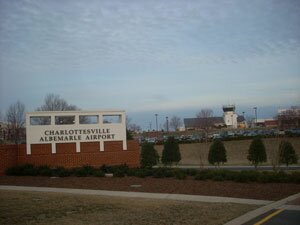
Could this local institution save millions with dredged dirt from the nearby Rivanna Reservoir?
PHOTO BY HAWES SPENCER
Even as entrepreneurs point to the success of runways made of silt in other cities, Charlottesville-Albemarle Airport officials– including the lawyer for an environmental group once known for avoiding lobbying– appear eager to downplay any role the Airport might play in a dredging plan that could save the silt-choked Rivanna Reservoir.
Documents recently obtained by the Hook also show Charlottesville's top executive dismissing citizen concerns and urging the water authority to proceed "full steam ahead" toward a potentially dangerous water source option.
"A solid majority of our citizens support this solution," boasts Charlottesville City Manager and Airport board member Gary O'Connell in a set of talking points emailed to City Councilors February 15 after questions began arising. (The Hook obtained the document through a Freedom of Information request.)
At issue is whether the waterworks, which the many-hatted O'Connell sits on, should allow two reservoirs to silt over in favor of a proposed Ragged Mountain mega-reservoir that kills 54,000 trees, runs under Interstate 64, and has such a small watershed that it requires a 9.5-mile pipeline from the Rivanna River to stay filled, plus treatment plant overhauls, all of which would cost taxpayers in excess of $142 million.
In January, a citizens group, fed up with what they perceive as misinformation, came together to raise questions about whether the Rivanna Water & Sewer Authority has been improperly swayed by Gannett Fleming, a Pennsylvania-based engineering firm that steered the Authority away from dredging the Rivanna Reservoir with frightening scenarios of truck-clogged roads, smoke-belching machinery, and a $225 million price tag. Private contractors have ridiculed the estimate as inflated, and the concerned citizens group has pointed out a potential conflict of interest.
Yet by February 21, O'Connell seemed to be downplaying such concerns in an email to Rivanna Authority director Tom Frederick.
"There is more the push from 'public' than the city leaders," writes O'Connell, seemingly mocking the new group, Citizens for a Sustainable Water Plan. "By the way," O'Connell adds, "I have gotten no public [nor] private direction from Council to change course. Full steam ahead."
"Full steam" in this case means a $3.1 million contract handed to Gannett Fleming in October for the design of a 112-foot dam that would clear-cut and flood 134 acres of forest in the Ragged Mountain Natural Area and kill another 50 acres of forest to create new access roads through that ecologically sensitive area southwest of Charlottesville.
Although Authority documents show that the contract can be canceled on 30 days' notice, neither O'Connell nor Frederick appears so inclined; and surveying, borings, and six-figure payments to the consultants have already begun. Still, Frederick has taken ample note of the controversy.
"It is becoming clear to me that this issue will not go away," he writes O'Connell in a March 5 email in which he proposes a new engineering study conducted by a firm other than Gannett Fleming.
"I would hope," Frederick adds, "that part of the 'deal' for the study would be that it be considered independent of the water supply plan and [that] design of the Ragged Mountain Dam continues to march on."
Six days later, Frederick gets into specifics. He says that a new study would cost$500,000 to $600,000, a prospect that doesn't sit well with his boss, Authority chair Mike Gaffney.
"I think this study, though politically correct, is a waste of RWSA funds," Gaffney responds later that day, March 11.
Fellow board member Gary Fern, who works at the Albemarle County Service Authority, the area's biggest water distributor, concurs in urging against another dredging study.
"To re-evaluate an alternative which was dismissed, when nothing has changed," Fern writes, "threatens the integrity of the RWSA and its consultant."
The Citizens, however, appear less worried about Gannett Fleming– which has already won nearly $6 million in consulting contracts from local water-buyers– than saving the Edgar Allan Poe-immortalized Ragged Mountain Natural Area from a 180-acre clear cutting– and the public from relying on a single reservoir that requires a quarter million dollars a year in electricity to pump water uphill into it.
The Citizens point out several facts contrary to claims that "a solid majority of our citizens support" the pipeline/mega-reservoir plan, which emerged near the end of a multi-year planning process. Not only has the plan never received a public hearing before Albemarle supervisors, its only official public hearing before Charlottesville City Council occurred last November, a full 17 months after Council green-lighted the idea of seeking a state permit.
The new dam/pipeline has prominent supporters. Several environmental groups, including the Piedmont Environmental Council, Friends of the Moormans River, and the Nature Conservancy– the group that proposed it– consider it the best way to simultaneously provide legally enforceable stream flows to the Moormans and Rivanna Rivers while providing enough drinking water to handle 50 years of population growth.
According to a recent press release by the Nature Conservancy, led locally by Ridge Schuyler, a former legislative director for former U.S. Senator Chuck Robb, the Conservancy developed "innovative, state-of-the-art flow releases" to give the Moormans River a natural flow "99 percent of the time, compared to 64 percent currently."
The Hook, however, has documented in previous articles that the Authority pitched the new pipeline/reservoir as necessary to cover an alleged drinking water "deficit" despite the fact that the Authority's own numbers show a) a sizable current capacity surplus, and b) that 50 years worth of water can be obtained simply by dredging the Rivanna Reservoir.
In addition, the Hook found that three existing lakes– Beaver Creek, Chris Greene, and Lake Albemarle– have not been studied as possible drought-time resources that might push the urban water system so far above 50-year demand that stream flows and thirsty urbanites could all be satisfied.
Another item recently discovered through case studies and comments from key regulators is that– unlike dredging wetlands and navigable waterways– reservoir dredging may require no regulatory oversight. But Authority chair Gaffney disagrees.
"Even maintenance dredging will be difficult to get through the approval process," Gaffney tells the Authority board in a March 11 email.
That's a particularly surprising claim considering that Gaffney, who didn't return calls for comment, was present at the April 18, 2005 meeting with multiple regulators where, as previously reported, environmental project manager Joseph Hassell of the Department of Environmental Quality said that the DEQ had never opposed a reservoir maintenance dredging.
Indeed, in the lone example of a Virginia municipality dredging its water source– a 1997 project by the City of Fairfax– the Hook found that the DEQ did not require a permit.
At the same 2005 regulatory pow-wow, an official named Michael Schwinn of the Army Corps of Engineers told Gaffney (as well as O'Connell, Frederick, and 15 other local officials) that unless the Rivanna muck were deposited in a wetland or waterway, his agency wouldn't require a permit to dredge the Reservoir.
Although Authority studies show that sedimentation will cause the Rivanna Reservoir to shrink to just 12 percent of its original size by the year 2050– a prospect suggesting that some kind of dredging must occur to avoid the wrath of boaters, anglers, and homeowners unaccustomed to viewing mud flats– Gaffney sees it differently. In an email, he predicts that reservoir-front homeowners "will do everything they can to prevent dredging from ever happening."
Likewise, Albemarle County Executive Bob Tucker, another Authority board member, predicts that "all hell will break loose" over dredging due to "noise, odor, [and] land needed for storing and drying the sediment and impact on transportation/roads."
But as the Hook has learned, while any dredging would indeed involve noise– from diesel-motored cutters and pumps– the smelly spoils can be pumped miles away. That would limit most road impacts and offer an opportunity for an entrepreneurial farmer outside the reservoir's periphery to get into the business of drying and perhaps selling topsoil.
Topsoil currently retails for $30 per cubic yard (about a ton) at Snow's Garden Center, a local landscaping business, and Snow's president Corbin Snow recent told a WINA radio audience that he expects that lake-bottom sediment would "absolutely" make a nutrient-rich topsoil.
The specialty products sales manager at Luck Stone, Allen Beasley, agrees.
"If you process it to screen it, clean it of sticks and rocks, and get it free of foreign material," says Beasley, "there's certainly a market for the finished product."
Then there's the airport.
Citizens Group member Joe Mooney wants to see whether dredging can help the Rivanna dispose of excess soil by sending it to the Charlottesville-Albemarle Airport, which wants 2.3 million cubic yards of fill for a runway expansion.
"I see this as a win-win situation," Mooney told Charlottesville City Council on March 3.
But recent comments from local officials suggest a variety of hurdles to deter anyone wishing to solve Charlottesville's water woes by moving fill from the bottom of the Rivanna Reservoir over to the Airport.
"I think it's important you not mix the two together," O'Connell told City Council on Monday, March 3.
As a member of the governing boards of both the Airport and Rivanna Authority, O'Connell would appear to have the perspective to determine what's best for the two organizations; yet the Citizens group, which includes two former Authority chairs, is frustrated by O'Connell's stance.
"I was puzzled and disappointed tonight to hear City Manager Gary O'Connell's negative and dismissive comments about the possibility of exploring a joint dredge/fill venture," Joe Mooney wrote in a post-meeting message City Council. "We need a City Manager who will look for creative, cost-saving ventures, not one who tries to block them."
Mooney added, "Ronald Reagan would have taken Mr. O'Connell to the woodshed for a learning experience."
While City Council hasn't gone that far, it has scheduled a May 6 work session aiming, as Mayor Dave Norris told a dirt-sharing advocate in an email, "to explore these very possibilities."
Certainly, lake-bottom sediments wouldn't be instantly suitable as structural fill. Dredgers agree that processing– including the removal of organic matter– would help the soil gain sufficient strength to support runways like those at New York's John F. Kennedy International Airport, which was completely built on fill.
About a decade ago, another Airport learned that lesson as a team of public and private sector officials took dredged sentiments from the Delaware River to build a new runway at Philadelphia International Airport. Their efforts garnered the "Hammer Award," a prize created by former Vice President Al Gore to reward creative cost-cutting in government and named for a notorious $436 Pentagon expenditure for a ball-peen.
The Philadelphia airport paid a fraction of what it was expecting for two million cubic yards of fill, and the Corps saved the expense of moving that material upland. In all, taxpayers saved $15 million, according to Corps spokesperson Ed Voigt.
"Private contractors make use of dredged fill all the time," says Voigt, "but this was a case of government using it."
Voigt– who earned his engineering degree from UVA in 1977– says such creative approaches are more typical of the private sector.
"It wasn't a super brainstorming situation," says Voigt. "It was a target of opportunity."
Unfortunately for taxpayers and water customers, one such opportunity has already been missed.
Dredging the Rivanna Reservoir has been discussed– to no effect– since the last century, particularly during the 2002 drought. The following year, ironically, the Charlottesville-Albemarle Airport awarded a multi-million-dollar construction contract that required nearly half a million cubic yards of dirt to be trucked in.
"That's the biggest fill job I've ever known," says Luck Stone's Beasley, whose company provided most of the dirt.
The project involved filling in a ravine south of the runway to bring the facility into compliance with updated FAA safety standards. (Expanding the Airport's footprint, the project also involved rerouting State Route 606, including the intersection with Route 743.)
While the project was good for Luck Stone's coffers, it put tens of thousands of trucks on local roads. According to Beasley, most of the fill originated from Luck's Ruckersville facility; the remainder was trucked in from Luck's plant on Route 250 East near Shadwell.
According to Airport financial records examined by the Hook, $4.55 million of the total $6.8 million safety zone project– 67 percent of the budget– was the purchase and delivery of fill. (About one quarter of the cost went to excavate dirt already on-site, but the rest– 476,665 cubic yards of fill– was trucked from Luck.)
Why wasn't it pumped?
For starters, the Authority hadn't yet commissioned its detailed dredging study. As previously reported, the Gannett Fleming report claiming that dredging would cost up to $145 million (an estimate later hiked to a top price of $225 million) emerged on December 1, 2004, more than a year after the airport expansion contract had been awarded.
Moreover, despite the fact that the Airport's master plan has long called for expansions at both runway ends, and despite the crossover in Rivanna and Airport board membership– besides O'Connell, County Executive Bob Tucker also sits on both– the dredging study failed to explore whether dirt could be obtained from the bottom of the Reservoir, which lies just two miles from the Airport (within easy piping distance).
And from the look of recent emails, dredging– wherever the spoils end up– remains a long way off, despite the fact the Airport's push for another multi-million-dollar expansion.
Airport director Barbara Hutchinson reports that she's already been cautioned against considering reservoir sediment by a member of her citizens' advisory board.
According to documents obtained by the Hook in a Freedom of Information request, Airport Commissioner Gregory Edwards paid a personal visit to Hutchinson to talk about dredging after Mooney first offered his fill-sharing proposal.
In a February 21 email to O'Connell, Hutchinson noted that Edwards explained that it "was not appropriate to include the Airport in any water resource conversations, including conversations regarding dredging."
Mooney stops short of condemning the communication, but he points out that besides serving on the Airport Commission, Edwards is an attorney who works for the Nature Conservancy, the organization most fervently pressing the pipeline/reservoir plan.
Founded in 1951, the Conservancy shot to fame during the 1970s for its philanthropic approach to saving the environment. Rejecting traditional eco-approaches of bully pulpit (Sierra Club) or colorful demonstration (Greenpeace), the multi-billion-dollar-endowed Conservancy focused instead on simply paying for eco-salvation by purchasing easements on threatened properties and sometimes buying land outright.
But, as revealed by a series of investigative articles in the Washington Post five years ago, that free-market approach veered toward free-wheeling, particularly when the Conservancy made below-market land sales to donors and developers. Today, a chastened Conservancy bills itself as a "science-based" organization.
Such scientific interest is evident locally in the Conservancy's role as architect of the controversial $143 million water plan, which public records show it hopes to use as a national model.
Supporters point to the plan's protection of historic stream flows in two rivers, but critics note anyone thinking of using this as a national model might want to reconsider clear-cutting about 54,000 trees to put a new reservoir under an Interstate highway as well as building an electricity-dependent pipeline and leaving the urban community's two existing reservoirs to silt up.
Is the Conservancy now assuming a role it once shunned, as lobbyist?
In a telephone interview, Edwards describes the Airport Commission's role as one simply of "eyes and ears" and denies trying to dissuade Hutchinson from eventually using Rivanna sediments. He explains he was simply trying to tell her that any dredging/Airport connection is a "premature" topic.
"You have to wait for the airport plan to trudge along," Edwards says, "and see if there's a tie-in point."
In a recent interview, Hutchinson stresses that she, too, wouldn't oppose fill-sharing, but she notes that because all Airport work must go to public bid, the winning contractor can't be required to procure fill from a particular spot. Fill (currently budgeted at $12 per cubic yard) would account for $27.6 million of the $53.2 million expansion, but Hutchinson insists the FAA won't pay for studies about what-ifs, such as using dredged fill.
Yet her email record indicates that she's done enough studying to conclude that an adjacent landowner wants the Airport to scrape dirt off his or her property. "That will be," she concludes, "the cheapest source of fill."
How does she know it's cheapest? Hutchinson says her comment came from conversations with engineers.
Equipment executive Steve Miller, who sells the "Mud Cat" line of dredges, points to an adage in his business: "There comes a time in every project when you have to shoot the engineers and get on with project. That time has come."
For Citizens group member Kevin Lynch, a former City Councilor who advocated dredging long before and long after Gannett Fleming portrayed it as too expensive, the roadblocks are frustrating.
"They're not just avoiding dredging," says an outraged Lynch. "They're actively resisting it."
But two entrepreneurs interviewed in earlier Hook stories– veteran runway builder Sam Artino of Florida-based National Hydraulic Dredging and local businessman Oliver Kuttner– are not resisting. They're clamoring for chance to dredge for a small fraction of what Authority director Frederick says it would cost (under $39 million vs. $220-225 million).
In an email to his board, Frederick offers another view of the free enterprise system, at least for dredging.
"One of the big arguments I keep hearing," Frederick writes March 11, "is that we did not 'investigate thoroughly enough.' If this were a private business answering to stockholders, we already have more than enough information to say 'no' to further study."
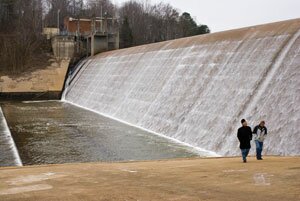
In its 2003 bid for an open-ended contract to serve as the local water consultant, Gannett Fleming headlined its proposal, "Doing more with what you have." Yet, the ensuing 50-year plan provides no funds for dredging the reservoir behind this dam.FILE PHOTO BY JAY KUHLMAN
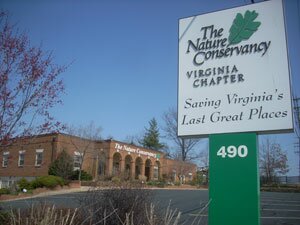
The Nature Conservancy used to eschew lobbying.
PHOTO BY HAWES SPENCER#
Correction: In the original printed version of this story, Gary O'Connell was described as chairing the Rivanna Water & Sewer Authority, but he is simply a board member. This online version of the story has been thusly corrected–editor.
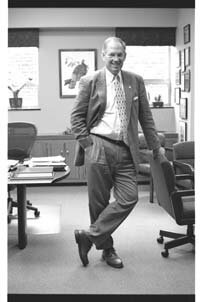

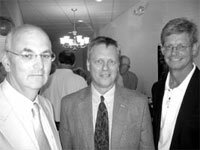
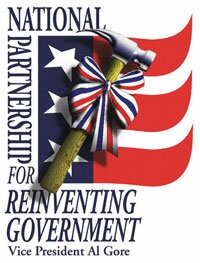
4 comments
The Nature Conservancy's Greg Edwards submitted the following letter to The Hook on Tuesday regarding its Sunday blog article.
Dear Editor:
I love my job at The Nature Conservancy, where I have worked for the last 20 years.
Although your article says that I am an attorney for the Conservancy, my duties for the Conservancy do not include the practice of law. I work in Charlottesville for the Conservancy’s international office as a fundraising trainer. I have not been involved in the local water supply plan.
My friends will tell you that I am opinionated, but I form my opinions only after gathering all the facts. Which is why I urge the Hook to publish the entire e-mail that is the subject of the story “Is the Conservancy Impeding the Dredge Options?,” as well as the Airport staff memo that was written before my meeting with the Airport’s executive director. These documents show:
• That I went seeking information about an issue that had been raised at City Council involving the airport’s runway expansion plan.
• The reasons that the airport expansion project doesn’t provide the easy solution to the community’s water storage that some have suggested.
• The tactics being employed by those who oppose the community’s water supply plan.
I also enjoy my life outside of work, which includes my hobby of flying airplanes. It was because of my life outside of work that I volunteered as a citizen to serve on the Joint Albemarle-Charlottesville Airport Commission (which is strictly advisory). I volunteered to help because I respect the Airport and its staff and what they are trying to achieve for the community.
In that capacity, I met with the Airport staff on February 21 to discuss numerous issues. One of them was the issue raised earlier in the week by a citizen at a City Council meeting. After having been briefed on the facts, I agreed with the conclusion of the airport staff—that “because of so many unanswered questions regarding the airport project, its funding and its schedule, the [Airport] Authority is not in a position to discuss dredge material at this time.”
Sincerely,
Greg Edwards
Here is the text of the e-mail that The Hook references in its article above.
From: Barbara Hutchinson
Sent: Thursday, February 21, 2008 3:05 PM
To:
Cc: [email protected]; Bob Tucker
Subject: Project Briefing - PLEASE READ
Importance: High
Gary:
I received a call from Aubrey asking me to respond to an issue raised at Tuesday night's City Council meeting. I watched the speaker online and have prepared a runway project briefing for the board's information, including staff's general response to issues raised this week regarding dredge material.
For everyone's information, the speaker was Joe Mooney. He recounted a telephone conversation with me to City Council in which we supposedly discussed the runway project, it's imminent construction, etc. and he went on to ask that City Council encourage the dredging of the South Fork Reservoir as the airport had this huge expansion starting and was a perfect place to dump the material.
He called the airport several weeks ago, and initially demanded copies of any documentation on how the fill material required for the runway extension project had been calculated. He was transferred to me, and he somewhat rudely asked that I tell him where he could obtain documents that "proved" the quantity of fill that would be required. I replied that we had no existing documents right now as the preliminary design had not been initiated, and could be anywhere from 2-24-60 months away.
He stated he read about it in the Progress and demanded to know where the information came from. I replied the reporter attended a board meeting and heard a discussion about the future project, but that the numbers were estimates prepared by the airport's engineers ; and, while it would benefit the airport to undertake the project in the near future, it had not been funded and might be years away. I asked his interest in the project, and he stated "my name is Joe Mooney and I'm a developer with fill I might want to sell the airport" and he promptly hung up.
Aside from a brief conversation with Ann Mallek during which I also expressed reservations given the questions that remained to be answered on our project alone, I have not discussed the project or dredging with anyone locally.
Today our Commission Chairman, Greg Edwards, visited and asked to discuss dredging. He is an attorney with The Nature Conservancy and stated the Conservancy was basically in agreement with RWSA plans but did have some relationship with 2 environmental groups that have sprung up supporting revisting the dredging issue. I restated our position that we are not part of water resources planning for the region, and reviewed my reservations regarding the acceptance of dredge material.
He likewise concluded it was not appropriate to include the airport in any water resource conversations, including conversations regarding dredging the reservoir. He stated that as it was appropriate, he would inform both of these groups that in his opinion, it is not beneficial to throw the airport in the middle of this issue.
I've prepared a brief report on the runway extension project and staff's comments regarding dredge material.
Please let me know if there is any other way I may provide assistance.
Best Regards,
Barbara
Barbara W. Hutchinson, C.M.
Executive Director
Charlottesville-Albemarle Airport Authority 100 Bowen Loop, Suite 200 Charlottesville, VA 22911
(434) 973-8342, Ext. 104
(434) 974-7476 Fax
(434) 409-7524 Mobile
I hope 60 minutes sticks it's nose in...it would be nice to see some of these stubborn people get a well deserved comeuppance.
"To re-evaluate an alternative which was dismissed, when nothing has changed," Fern writes, "threatens the integrity of the RWSA and its consultant."
The integrity has already been severely damaged when reputations and feelings are put ahead of good government. It's time to clean house, beginning with Gary O'Connell. I noticed that the alternative was described as "dismissed" rather than "fully vetted." The more these people talk, the more the public can see they really don't have a leg to stand on.